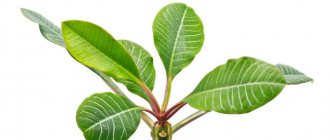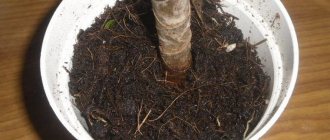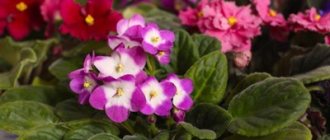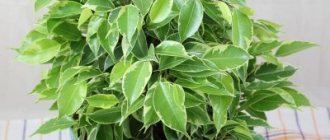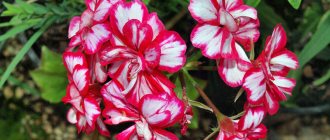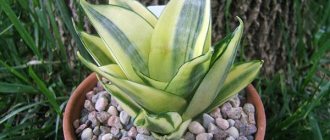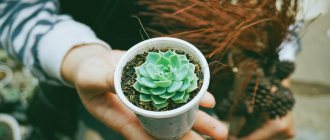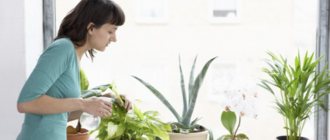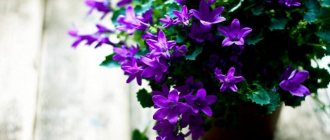One of the most popular indoor plants is Dieffenbachia.
Despite the fact that it comes from South America, it can be successfully grown at home.
In order for the plant to be healthy and enjoy its attractive appearance for a long time, it is necessary to provide it with proper care.
Description of the plant
Dieffenbachia is a plant that belongs to the evergreen Araceae family. The regions of America located in the tropical zone are recognized as the birthplace of the flower. The flower received its name from Joseph Dieffenbach, a gardener from Austria.
Many types of Dieffenbachia act as houseplants. They are characterized by a thick stem ending in a tip of leaves that have an elongated oval shape and variegated color. Outside of the wild, the plant blooms very rarely, so not everyone will be able to see the white cob. However, the short flowering period, which lasts a couple of days, occurs in the middle - end of spring. The fruit is an orange-red berry.
A characteristic feature of the plant is its rapid growth. In a short period of time, Dieffenbachia can noticeably stretch out.
Dieffenbachia can reach 2 meters in height, but with such a large growth, the lower part of the stem becomes yellowish, which does not look particularly decorative.
Dieffenbachia juice is believed to be poisonous. This is why many gardeners and flower growers sometimes avoid planting plants. The flower is used in some countries as a drug to kill rats. The plant is safe for humans if not eaten. When processing and cutting parts of an indoor beauty, it is best to arm yourself with gloves. You should not have a flower in your house if there are pets living in it who love to bite everything around it. The sap of the plant, if it gets on their tongue, can cause illness or death.
Trimming
In addition to the fact that you often have to cut off damaged leaves of a flower, it is also important to pinch the top in time. As a rule, a bare lower trunk and a lot of leaves at the top indicate that it’s time to take action.
Things to remember when starting pruning:
- We work only with gloves (you can even wear glasses to protect your eyes from the caustic juice);
- We treat sharp tools with alcohol (after trimming too);
- Wipe the cut area dry with a napkin and sprinkle with activated carbon.
How much to trim? There are no strict rules here, the main thing is to leave at least 10 centimeters of the stem. Even a bare stem quickly recovers after pruning and can quickly increase the mass of leaves.
Varieties of Dieffenbachia
The plant has several different species that differ in external characteristics. At the moment, there are several main varieties:
Baumann. The species is distinguished by very large leaves, which often reach 80 cm in length.
Camilla. Most of the leaves that form the shape of the bush are light yellow. Only at the edge there is a border of a light green hue. An important property of Camilla is endurance and unpretentiousness.
Leopold. It is rarely found among amateur gardeners. The plant has a short and thick trunk, as well as wide leaves growing in the shape of an ellipse.
Nice. Dark green leaf blades are colored with light veins. The variety grows up to 1.5 m and tolerates drought and hot conditions.
Dieffenbachia spotted
Spotted. The leaves are close to round in shape and have a pointed top. Features: spots of yellow and white on a dark green background. The plant grows 1 m in height.
Seguina. Outwardly, it resembles a spotted variety, from which it differs in the width of its leaves. The bush species is widely used in breeding.
Oersted. The leaves have a bluish-green color and a light vein in the center. The length of the dense leaves reaches 35 cm, and the shape resembles a heart.
Botanical characteristics
Growing an indoor evergreen herbaceous plant is not too difficult. The plant has thick and straight, fairly fleshy stems and large, oblong, glossy or matte alternate leaves. Varieties with green or variegated foliage are well known. Variegated species have an attractive appearance, and the leaves are covered with a pattern represented by light green or yellow specks, stripes and spots. It is thanks to its high decorative value that the plant is in great demand in indoor culture.
Particularly popular are Dieffenbachia spotted and Dieffenbachia variegated, which became the progenitors of a large number of hybrid forms that differ in size and color of leaf plates. The indoor flower is characterized by rapid growth rates. Proper cultivation and creation of comfortable conditions allows the plant to form one new leaf every week. The upper part of the shoot has a growth point, but at home the height of an adult indoor flower varies between 0.5-2 m. Some varietal varieties have dormant buds, the awakening of which causes the plant to tiller.
Over time, the foliage on the stem part turns yellow, dries out and falls off, which causes the trunk part to become exposed, and the plant becomes like a palm tree with succulent, variegated leaves at the apical part. If the plant loses its decorative qualities, it needs to be re-rooted. Some types require mandatory updating every three years.
Dieffenbachia blooms in mid-summer, but in the conditions of indoor floriculture, the ornamental crop acquires flowers extremely rarely. Along with other representatives of the Aronia family, Dieffenbachia flowers are small in size, yellowish-white in color, and completely inconspicuous. Then small and bright, orange-red berries ripen on the plant. This process provokes inhibition of growth and shedding of the lower foliage, so experienced amateur gardeners remove the buds completely.
Planting Dieffenbachia at home
Before planting a flower, you should decide on the container in which it will live. The most important condition is that the size of the pot matches the size of the root system. Dieffenbachia grows quite quickly, so it is important to slow down its growth and not take a pot that is too large. It is recommended to give preference to natural materials for the container, such as clay or ceramics. There must be a through hole at the bottom.
Preparing the soil for Dieffenbachia
The soil for planting the plant must be loose, since the roots need to receive air to ensure life. In addition, water will not be retained, and the soil will be able to be evenly saturated with moisture and saturate the flower. You can create the soil yourself by taking 2/3 of the universal one from the flower shop, and adding to it a third of the baking powder, which can be sand or perlite. You can add regular activated carbon to it, which will help avoid rotting of the root system. It is worth laying a drainage layer at the bottom of a pot or other container.
Lighting
In the wild, the plant lives in tropical forests under the canopies of tall trees. Therefore, direct sun is destructive for Dieffenbachia . If a flower is exposed to the sun, its delicate leaves get severe burns. The optimal lighting for it is light partial shade.
Dieffenbachia also grows well in bright but diffuse lighting. It should not be placed in the shade. Lack of lighting will cause excessive elongation of the shoots and their severe weakening. With a lack of light, a flower quickly loses its decorative effect.
In winter, Dieffenbachia most often suffers from insufficient lighting. You should move it to the most illuminated southern window sill. You should not be afraid of direct sun in winter; during this period it will not harm the flower.
Caring for Dieffenbachia at home
The fact that Dieffenbachia does not require special care does not negate the fact that certain rules should be followed when growing the plant. The natural environment is the most favorable for the plant. This means that a person trying to grow such a flower at home must provide it with everything necessary. In the wild, Dieffenbachia receives moisture and warmth, so for comfortable living, it needs the same conditions in the house.
How to water Dieffenbachia
The plant needs to be watered abundantly from spring to autumn. A third of the soil should have time to dry out, and only then can watering be done.
In winter, the amount of watering should be small, because otherwise the root system will begin to rot and the Dieffenbachia will die.
Expert opinion
Oksana Alexandrovna
A gardener with extensive experience. Vegetable gardening is more than just a hobby for me.
Do not water the plant with cold tap water. Cold can quickly destroy a flower.
The liquid for irrigation should be soft and clean. It is best to use water that has stood at room temperature for some time. Both boiled and tap liquids that do not contain manium and calcium salts are suitable for this. Such chemicals can poison the plant and completely destroy it.
Lighting and location
The light should be bright, but not so bright that the leaf blades become covered with burn spots. It is not necessary to place the pot on the windowsill; you can go 1-2 meters deeper into the room.
Expert opinion
Oksana Alexandrovna
A gardener with extensive experience. Vegetable gardening is more than just a hobby for me.
Do not place the flowerpot in the dark. The lack of light will negatively affect the leaves, which will stop growing and lose their beautiful decorative coloring.
It is recommended to turn the pot the other side towards the light at least once a week. Otherwise, the leaves will grow only on one side, which is why the flower will look unsightly and crooked.
The location must be selected so that there is absolutely no possibility of drafts.
Feeding Dieffenbachia
During the period of active growth, which lasts from mid-spring to the end of summer, the flower needs to be fed with additives. With a lack of nutrition, the leaves will begin to turn yellow, wither and dry out. Organic and mineral fertilizers are well suited for the crop and should be applied once every 2 weeks. In winter, fertilizing can be done 2 times less often in order to saturate Dieffenbachia with vitamins and minerals.
Feeding Dieffenbachia with liquid fertilizer
Dieffenbachia pruning
To limit the rapid growth of the plant, some people are looking for ways to root Dieffenbachia. In this case, they prefer to limit growth by pinching shoots. In addition, the tops of the flowers are often cut off. When carrying out such a procedure, it is worth remembering the toxic properties of the plant sap. Before pruning Dieffenbachia, you need to protect yourself with rubber gloves and act carefully. After cutting, the wounded areas must be treated with activated carbon.
If the plant begins to bloom, it is best to remove the cob.
Air temperature and humidity
Under normal conditions, Dieffenbachia grows in warm conditions. She is uncomfortable with drafts, cold and strong temperature changes, which can destroy the plant.
Optimal temperatures for Dieffenbachia:
| Spring Summer | +20 +25 degrees |
| Autumn winter | +16 +18 degrees |
Already at +10 degrees the plant begins to die, so in winter it is recommended to turn on the heating.
Air humidity should not fall below 65%. It is best to periodically spray the plant with warm water and wipe the leaves with a damp sponge.
Temperature
The homeland of Dieffenbachia is the hot tropics, so it loves warmth very much and is afraid of sudden temperature swings. Comfortable temperatures for her are from 22 to 28 in the summer. In winter, it tolerates temperatures from 17 to 22 degrees well, but if it is below 10 °C, it can get sick and even die.
The plant enjoys being in the fresh air, but it is afraid of drafts. Therefore, we ventilate, but so that our queen does not get blown out.
In general, it is very easy to care for and grows very quickly.
Transplantation and propagation of Dieffenbachia
Young plants can be replanted once a year. It is important to select the next container correctly. It is recommended to take a pot a couple of centimeters larger than the previous pot. Adult specimens should be disturbed much less frequently and replanted only every 4 years.
Dieffenbachia transplant
Replanting a plant requires care and caution. It is best to act according to a certain algorithm so as not to harm Dieffenbachia.
- Take a new pot for Dieffenbachia and place a drainage layer on the bottom.
- Place a small amount of soil on top.
- Remove the plant from the pot and carefully examine its roots. If defects are found on the roots, it is best to cut them off. The cut areas will need to be treated with activated carbon.
- Without shaking off the soil, you need to move the Dieffenbachia to a new pot.
- Fill the sides with soil and water the flower.
When the plant has reached a large size, you should not send it to a new, deeper container. It will be enough to update the top layer of soil.
In order to learn how to propagate Dieffenbachia at home, you need to study 4 different methods:
Seeds. This method is used by specialist breeders to develop new varieties. Seeds are obtained by hand pollinating male and female flowers.
Top cuttings. When the plant is stretched upward and the stem has no leaves, the top is cut off. It is placed in water or a peat-sand mixture. During the growth process, it is recommended to spray the cuttings and protect them from direct rays.
Stem pieces. The pieces are cut into several cuttings up to 20 cm in length. They are dried for 2 days and then placed in a substrate of sand and peat. After this, the container is covered with film and remains at a temperature of +25 degrees for 6 months.
Propagation of Dieffenbachia by stem pieces
Layerings. A cut is made on the stem and wrapped with film. All this is fixed with tape or thread, and after that you can observe the appearance of roots, which are cut off and planted in a separate pot.
Diseases
Each decorative flower is characterized by ailments. Most of them appear due to improper care or living conditions that do not correspond to natural conditions.
Rot
Some types of fungi cause root rot, which is externally manifested by dark depressions on the roots and necks. Gradually, the infection spreads to the trunk, which breaks under its own weight. Sometimes there is a pale gray mycelium that spots the entire underground system.
The causative agent of the disease lives in the soil and spreads through it. It is activated during overflow, when the soil is moistened for a long time, but there is no drainage or it cannot cope. Prevention - special substrates for Dieffenbachia and potash fertilizers.
To combat the disease, you need to replant the bush with a complete replacement of the earthen clod, temporarily stop watering and treat it with Previkur.
Viral mosaic
The disease manifests itself as mosaic spotting, which becomes a harbinger of slower growth until complete recovery. The pathogen is transmitted by aphids and remains dormant on affected plants for a long time.
Insecticides are used for prevention and treatment. It is better to burn a severely affected plant. It's unlikely to come out.
Leaves are falling
Indoor Dieffenbachia leaves often fall off - this is an inevitable process that negatively affects its decorative effect. Only an update will help. The same symptoms in a young plant indicate improper care.
Dry leaf tips
These signs are characteristic of dry air at high temperatures. They can be observed both along the edge and in the center of the leaf plate. Most often, trouble occurs during the winter heating season or in the hot summer, when owners do not care about additional spraying of water using special devices.
Pale leaves
Most likely, lack of sunlight or mineral nutrition. In this case, the stem may stretch in the direction of the light source and new leaves will become smaller. It is enough to provide the plant with the required amount of diffused sunlight. It cannot be kept in partial shade.
The leaves are curling up
The cause of the disease is unfavorable external factors: drafts, cold in the room. If the phenomenon has become permanent, this indicates an imbalance in the salt balance in the soil (lack of nutrition) or its increased density (oxygen deficiency).
The way out of the situation is to replant using the transshipment method, with partial removal of the earthen clod. It is important to use settled water of low hardness and room temperature for irrigation, and also not to overuse fertilizing.
Brown spots
The plant itself will “tell” about the overflow - with brown spots on the leaves, loss of turgor and yellowing. You should let the soil dry, and then water it with a mixture of water and an antifungal agent or a solution of potassium permanganate to avoid the appearance of rot.
Problems you may encounter when growing Dieffenbachia
If basic care rules are not followed, you may encounter some difficulties.
The main most common problems include yellowing of leaves, lethargy, drying out and lack of plant growth. In order to solve them, it is worth establishing the cause.
Yellowing leaves can be caused by exposure to direct sunlight, while leaf lethargy is a result of rot and poor drainage. To solve the first problem, it is enough to move the pot to a less lit room, and when curling the leaves, you need to remove the flower, inspect the roots and change the soil. Drying of leaf blades is often caused by drought, so it is worth spraying Dieffenbachia leaves more often. Lack of plant growth hints at cold or inappropriate lighting.
In addition, the plant may be susceptible to parasites or diseases. The main pests that attack Dieffenbachia are mealybugs, scale insects and spider mites. When they appear, it is necessary to treat the flower with insecticides, which are available at any flower shop.
Professional help from gardeners and gardeners Still have questions? Ask, don't hesitateAsk a question
The most common disease is rotting. It can be caused by improper or excessive watering. The plant will begin to wither and the leaves will dry out. If such signs appear, it is recommended to remove the plant from the pot and inspect its root system. If there are damaged parts, it is necessary to resort to their removal.
Top dressing
We feed with mineral and organic fertilizers with a predominance of nitrogen at least once a month. The feeding period is from late spring to September. If we have just transplanted a flower, it is better to let it adapt for two or three weeks without feeding.
If you regularly stimulate Dieffenbachia with fertilizers, there is a chance that it will bloom. But in general, with proper care, the plant feels great even without feeding.
The soil
Dieffenbachia grows well in soil with an acidity of 5.6-5.8. The soil for Dieffenbachia should be well permeable to water and air. This will allow oxygen to penetrate to the roots of the flower, and water will flow away without stagnating in the soil.
A universal substrate for decorative deciduous plants with the addition of peat is suitable..
When using such an earthen mixture, it is recommended to add charcoal to its composition.
When making soil for Dieffenbachia yourself, you can use the following compositions:
- 4 parts leaf soil, 2 parts peat, 2 parts dry moss, 1 part sand and 0.5 parts charcoal;
- 4 parts leaf soil, 1 part sand, peat and humus, 0.5 parts charcoal.
Similar articles:
- Propagation of Dieffenbachia by cuttings and seeds
- Causes of yellowing of Dieffenbachia leaves
